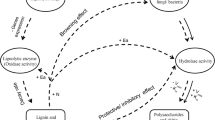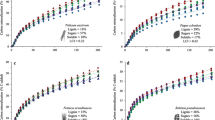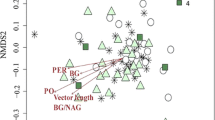Abstract
Decomposition of plant material is a complex process that requiresinteraction among a diversity of microorganisms whose presence and activity issubject to regulation by a wide range of environmental factors. Analysis ofextracellular enzyme activity (EEA) provides a way to relate the functionalorganization of microdecomposer communities to environmental variables. In thisstudy, we examined EEA in relation to litter composition and nitrogendeposition. Mesh bags containing senescent leaves of Quercusborealis (red oak), Acer rubrum (red maple) andCornus florida (flowering dogwood) were placed on forestfloor plots in southeastern New York. One-third of the plots were sprayedmonthly with distilled water. The other plots were sprayed monthly withNH4NO3 solution at dose rates equivalent to 2 or 8 g N m−2 y−1. Mass loss, litter composition, fungal mass, and the activities ofeight enzymes were measured on 13 dates for each litter type. Dogwood wasfollowed for one year, maple for two, oak for three. For each litter type andtreatment, enzymatic turnover activities were calculated from regressions of LN(%mass remaining) vs. cumulative activity. The decomposition of dogwood litterwas more efficient than that of maple and oak. Maple litter had the lowestfungal mass and required the most enzymatic work to decompose, even though itsmass loss rate was twice that of oak. Across litter types, N amendment reducedapparent enzymatic efficiencies and shifted EEA away from N acquisition andtoward P acquisition, and away from polyphenol oxidation and towardpolysaccharide hydrolysis. The effect of these shifts on decomposition ratevaried with litter composition: dogwood was stimulated, oak was inhibited andmaple showed mixed effects. The results show that relatively small shifts intheactivity of one or two critical enzymes can significantly alter decompositionrates.
Similar content being viewed by others
References
Anonymous 1992. Standard methods for the examination of water and wastewater. 18th edn. APHA, AWWA, WPCF.
Antibus R.K. and Sinsabaugh R.L. 1993. The extraction and quantification of ergosterol from ectomycorrhizal fungi and roots. Mycorrhiza 3: 137-144.
Berendse F., Berg B. and Bostatta E. 1987. The effects of lignin and nitrogen on the decomposition of litter in nutrient-poor ecosystems: a theoretical approach. Canadian Journal of Botany 65: 1116-1120.
Berg B. 1986. Nutrient release from litter and humus in coniferous forest soils-a mini review. Scandinavian Journal of Forest Research 1: 359-369.
Berg B. and Ekbohm G. 1991. Litter mass loss rates and decomposition patterns in some needle and leaf litter types. Long term decomposition in a Scots pine forest. Canadian Journal of Botany 69: 1449-1456.
Berg B. and Matzner E. 1997. Effect of N deposition on decomposition of plant litter and soil organic matter in forest systems. Environmental Reviews 5: 1-25.
Blanchette R.A. 1991. Delignification by wood-decay fungi. Annual Review of Phytopathology 29: 381-398.
Burns R.G. 1983. Extracellular enzyme-substrate interactions in soil. In: Slater J.H., Whittenbury R. and Wimpenny J.W.T. (eds), Microbes in their Natural Environments. Cambridge University Press, Cambridge, pp. 249-298.
Carreiro M.M., Sinsabaugh R.L., Repert D.A. and Parkhurst D.F.2000. Microbial enzyme shifts explain litter decay responses to simulated nitrogen deposition. Ecology 81: 2359-2365.
Chet I., Inbar J. and Hadar Y. 1997. Fungal antagonists and mycoparasites. In: Wicklow D.T. and Söderström B. (eds), The Mycota, Vol. IV-Environmental and Microbial Relationships. Springer-Verlag, Berlin, pp. 165-184.
Dighton J. 1997. Nutrient cycling by saprotrophic fungi in terrestrial habitats. In: Wicklow D.T. and Söderström B. (eds), The Mycota, Vol. IV-Environmental and Microbial Relationships. Springer-Verlag, Berlin, pp. 271-280.
Dix N.J. and Webster J. 1995. Fungal Ecology. Chapman & Hall, London.
Driscoll K. 2001. Effects of chronic nitogen deposition on soil microbial communities in a sugar maple forest in northern Michigan. MS thesis, University of Toledo.
Eriksson K.-E., Blanchette R.A. and Ander P. 1990. Microbial and enzymatic degradation of wood components. Springer-Verlag, Berlin.
Fog K. 1988. The effect of added nitrogen on the rate of decomposition of organic matter. Biological Reviews 63: 433-462.
Gessner M.O. and Chauvet E. 1993. Ergosterol-to-biomass conversion factors for aquatic hyphomycetes. Applied and Environmental Microbiology 59: 502-507.
Gessner M.O., Suberkropp K. and Chauvet E.1997. Decomposition of plant litter by fungi in marine and freshwater ecosystems. In: Wicklow D.T. and Söderström B. (eds), The Mycota, Vol. IV-Environmental and Microbial Relationships. Springer-Verlag, Berlin, pp. 303-322.
Hammel K.E. 1997. Fungal degradation of lignin. In: Cadisch G. and Giller K.E. (eds), Driven by nature: Plant litter quality and decomposition. CAB International, Wallingford, pp. 33-46.
Heal O.W., Anderson J.M. and Swift M.J. 1997. Plant litter quality and decomposition: An historical overview. In: Cadisch G. and Giller K.E. (eds), Driven by nature: Plant litter quality and decomposition. CAB International, Wallingford, pp.3-32.
Jackson C., Foreman C. and Sinsabaugh R.L. 1995. Microbial enzyme activities as indicators of organic matter processing rates in a Lake Erie coastal wetland. Freshwater Biology 34: 329-342.
Kirk T.K. and Farrell R.L. 1987. Enzymatic 'combustion': The microbial degradation of lignin. Annual Review of Microbiology 41: 465-505.
Magill A.H. and Aber J.D. 1998. Long-term effects of experimental nitrogen additions on foliar litter decay and humus formation in forest ecosystems. Plant and Soil 203: 301-311.
Melillo J.M., Aber J.D. and Linkins A.E. 1989. Carbon and nitrogen dynamics along the decay continuum: plant litter to soil organic matter. Plant and Soil 115: 189-198.
Miller R.M. and Lodge D.J. 1997. Fungal responses to disturbance: Agriculture and forestry. In: Wicklow D.T. and Söderström B. (eds), The Mycota, Vol. IV-Environmental and Microbial Relationships. Vol. 4. Springer-Verlag, Berlin, pp. 65-84.
Moorhead D.L., Sinsabaugh R.L., Linkins A.E. and Reynolds J.F. 1996. Decomposition processes: Modelling approaches and applications. Science of the Total Environment 183: 137-149.
Newell S.Y. 1994. Total and free ergosterol in mycelia of saltmarsh ascomycetes with access to whole leaves or aqueous extracts of leaves. Applied and Environmental Microbiology 60: 3479-3482.
Paustian K., Ågren G. and Bosatta E. 1997. Modelling litter quality effects on decomposition and soil organic matter dynamics. In: Cadisch G. and Giller K.E. (eds), Driven by nature: Plant litter quality and decomposition. CAB International, Wallingford, pp. 313-336.
Rayner A.D.M. 1995. Fungi, a vital component of ecosystem function in woodland. In: Allsop D., Colwell R.R. and Hawksworth D.L. (eds), Microbial Diversity and Ecosystem Function. CAB International, New York, pp. 231-254.
Sinsabaugh R.L. and Findlay S. 1995. Microbial production, enzyme activity and carbon turnover in surface sediments of the Hudson River Estuary. Microbial Ecology 30: 127-141.
Sinsabaugh R.L., Klug M.J., Collins H.P., Yeager P. and Petersen S.O. 1999. Characterizing soil microbial communities. In: Robertson G.P., Bledsoe C.S., Coleman D.C. and Sollins P. (eds), Standard Soil Methods for Long Term Ecological Research. Oxford University Press, New York, pp. 476-525.
Sinsabaugh R.L. and Moorhead D.L. 1994. Resource allocation to extracellular enzyme production: A model for nitrogen and phosphorus control of litter decomposition. Soil Biology & Biochemistry 26: 1305-1311.
Sinsabaugh R.L. and Moorhead D.L. 1997. Synthesis of litter quality and enzyme approaches to decomposition modeling. In: Cadisch G. and Giller K.E. (eds), Driven by Nature: Plant Litter Quality and Decomposition. CAB International, Wallingford, pp. 363-375.
Sinsabaugh R.L., Moorhead D.L. and Linkins A.E. 1994a. The enzymic basis of plant litter decomposition: emergence of an ecological process. Applied Soil Ecology 1: 97-111.
Sinsabaugh R.L., Osgood M. and Findlay S. 1994b. Enzymatic models for estimating decomposition rates of particulate detritus. Journal of the North American Benthological Society 13: 160-169.
Söderström B., Bå å th E. and Lundgren B. 1983. Decrease in soil microbial activity and biomasses owing to nitrogen amendments. Canadian Journal of Microbiology 29: 1500-1506.
Stevenson F.J. 1994. Humus Chemistry. 2nd edn. John Wiley & Sons, New York.
Tank J.L., Webster J.R., Benfield E.F. and Sinsabaugh R.L. 1998. Effect of leaf litter exclusion on microbial enzyme activity associated with wood biofilms in streams. Journal of the North American Benthological Society 17: 95-103.
Van Soest P.J., Robertson J.B. and Lewis B.A. 1991. Methods for dietary fiber, neutral detergent fiber, and nonstarch polysaccharides in relation to animal nutrition. Journal of Dairy Science 74: 3583-3597.
Widden P. 1997. Competition and the fungal community. In: Wicklow D.T. and Söderström B. (eds), The Mycota, Vol. IV-Environmental and Microbial Relationships. Springer-Verlag, Berlin, pp. 135-148.
Zak J.C. and Rabatin S.C. 1997. Organization and description of fungal communities. In: Wicklow D.T. and Söderström B. (eds), The Mycota, Vol. IV-Environmental and Microbial Relationships. Vol. 4. Springer-Verlag, Berlin, pp. 33-46.
Author information
Authors and Affiliations
Rights and permissions
About this article
Cite this article
Sinsabaugh, R., Carreiro, M. & Repert, D. Allocation of extracellular enzymatic activity in relation to litter composition, N deposition, and mass loss. Biogeochemistry 60, 1–24 (2002). https://doi.org/10.1023/A:1016541114786
Issue Date:
DOI: https://doi.org/10.1023/A:1016541114786




